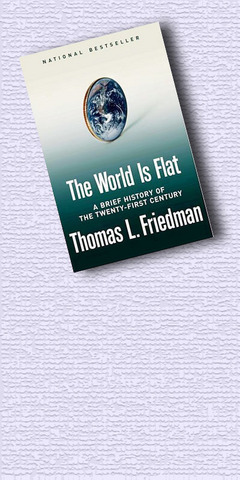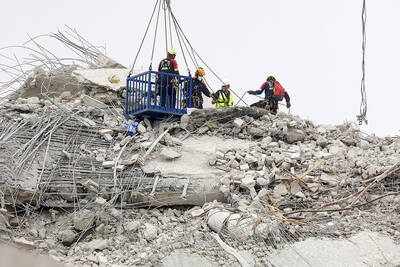Listen up American students, Professor Friedman has a lesson for you: Globalization is revolutionizing the world.
Like it or not, the sooner you adapt to all the technological and geopolitical changes, the brighter your futures will become. And the US won't be wondering what happened to its superpower status when the world became flat. Columbus may roll in his grave, but repeat these words: The world is flat.
Not only does Professor Friedman believe it, he has seen it firsthand. "Professor Friedman" is actually award-winning New York Times columnist Thomas Friedman, and his story should be read by everyone who is interested in how the world is quickly shrinking in the early 21st century.

Friedman is not a professor (although he has served as visiting professor at Harvard University) but his latest book, The World is Flat: A Brief History of the 21st Century, feels very much like a college textbook. It's large, scholarly and quite educational. And thanks to Friedman's clear and punchy prose, it's better than most textbooks.
The World is Flat is an updated version of Friedman's first book on globalization, The Lexus and the Olive Tree, which was published only five years ago. In his new book, Friedman admits that he got caught up in 9/11 and the subsequent wars in Afghanistan and Iraq and lost sight of globalization's latest movements.
"Globalization 3.0" is what he calls his latest chronicle on the rapid convergence of technology and economics that has smashed borders and has caused both joy and anxiety to humans and political systems.
"If I am right about the flattening of the world," Friedman writes, "it will be remembered as one of those fundamental changes -- like the rise of the nation-state or the Industrial Revolution -- each of which, in its day ... produced changes in the role of individuals, the role and form of governments, the way we innovated and the way we conducted business."
Friedman's book doesn't break any new ground or offer a sure-fire way to cope with such rapid and complex changes. But Friedman, a three-time winner of the Pulitzer Prize, is a masterful observer and has a unique talent for relating to the common man. Plus he's a relentless interviewer, traversing the globe like Nellie Bly and getting everyone's input on the flat world, including Microsoft co-founder Bill Gates and former Mexican president Ernesto Zedillo.
Despite the intricate subject, The World is Flat is enjoyable to read -- most of the time. Friedman gets carried away with some of the more minute developments of globalization (triple convergence and various economic theories) and seems to repeat himself occasionally. Like a passionate professor, he's not afraid to lecture, but he does it in a likeable way after carefully presenting his case.
The World is Flat primarily focuses on two emerging giants on the world stage -- India and China. The lowering of trade and political barriers and huge advances in technology have allowed the two Asian countries to level the global playing field and compete for superpower status.
Friedman writes that Globalization 3.0 isn't about major corporations but about empowering the individual, mainly through the Internet and related technologies. China and India have competed and won low-wage manufacturing and information jobs and are on the fast track to creating wealthier, more intelligent societies. Friedman writes that young Chinese and Indians are ambitious and very hungry.
"Young Chinese and Indians are not racing us to the bottom. They are racing us to the top," writes Friedman. "They want to dominate us -- in the sense that they want to be creating the companies of the future that people all over the world will admire and clamor to work for."
Wisely, Friedman doesn't turn The World is Flat into a current-events essay. He spends almost the first half of it dealing with how events in the late 1980s and 1990s molded our current world. He likes to call this period "from 11/9 to 9/11," meaning from the fall of the Berlin Wall on Nov. 9, 1989, to the terrorist attacks in the US on Sept. 11, 2001. These 200 pages are the most fascinating in the book, many of which deal with how the World Wide Web seemingly came out of nowhere and changed the world forever.
Throughout the book but especially in later chapters, Friedman addresses how America has fallen behind in the flat world, especially when producing top-quality scientists and engineers.
Although the US isn't in a crisis now, he says Americans aren't as ambitious as their global brethren.
"In China today, Bill Gates is Britney Spears," Friedman writes about China's celebrity-like obsession with the computer pioneer. "In America today, Britney Spears is Britney Spears -- and this is our problem."
Friedman also presents a darker side to the flat world, especially how terrorists and the al-Qaeda network have exploited it to cause death and destruction.
"In a flat world, if you don't visit a bad neighborhood, it might visit you," he writes. However, "you can flourish in this flat world, but it does take the right imagination and the right motivation."

A vaccine to fight dementia? It turns out there may already be one — shots that prevent painful shingles also appear to protect aging brains. A new study found shingles vaccination cut older adults’ risk of developing dementia over the next seven years by 20 percent. The research, published Wednesday in the journal Nature, is part of growing understanding about how many factors influence brain health as we age — and what we can do about it. “It’s a very robust finding,” said lead researcher Pascal Geldsetzer of Stanford University. And “women seem to benefit more,” important as they’re at higher risk of

Eric Finkelstein is a world record junkie. The American’s Guinness World Records include the largest flag mosaic made from table tennis balls, the longest table tennis serve and eating at the most Michelin-starred restaurants in 24 hours in New York. Many would probably share the opinion of Finkelstein’s sister when talking about his records: “You’re a lunatic.” But that’s not stopping him from his next big feat, and this time he is teaming up with his wife, Taiwanese native Jackie Cheng (鄭佳祺): visit and purchase a

Experts say that the devastating earthquake in Myanmar on Friday was likely the strongest to hit the country in decades, with disaster modeling suggesting thousands could be dead. Automatic assessments from the US Geological Survey (USGS) said the shallow 7.7-magnitude quake northwest of the central Myanmar city of Sagaing triggered a red alert for shaking-related fatalities and economic losses. “High casualties and extensive damage are probable and the disaster is likely widespread,” it said, locating the epicentre near the central Myanmar city of Mandalay, home to more than a million people. Myanmar’s ruling junta said on Saturday morning that the number killed had

Mother Nature gives and Mother Nature takes away. When it comes to scenic beauty, Hualien was dealt a winning hand. But one year ago today, a 7.2-magnitude earthquake wrecked the county’s number-one tourist attraction, Taroko Gorge in Taroko National Park. Then, in the second half of last year, two typhoons inflicted further damage and disruption. Not surprisingly, for Hualien’s tourist-focused businesses, the twelve months since the earthquake have been more than dismal. Among those who experienced a precipitous drop in customer count are Sofia Chiu (邱心怡) and Monica Lin (林宸伶), co-founders of Karenko Kitchen, which they describe as a space where they